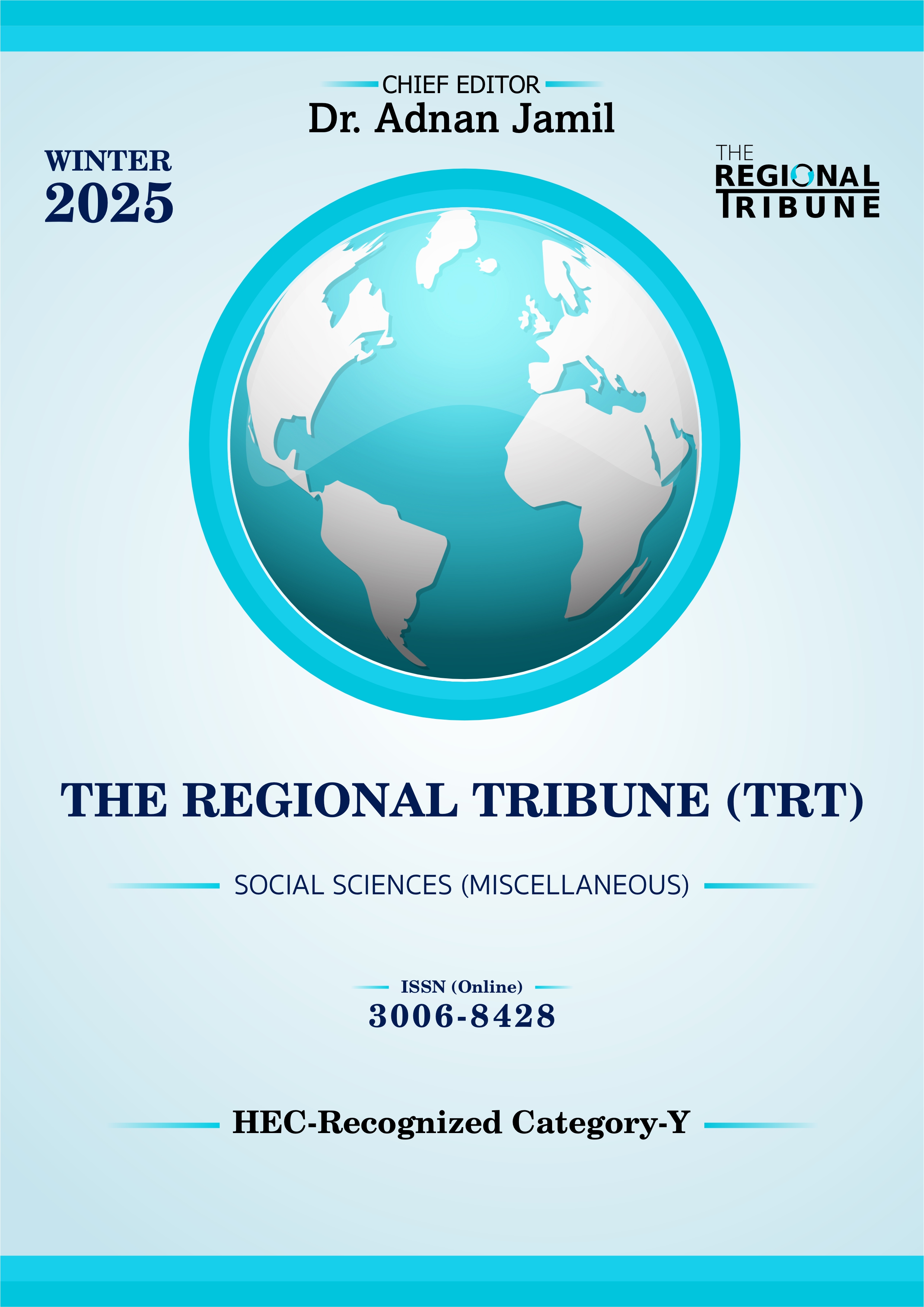Resilience as a Bridge: Unpacking the Impact of Workplace Bullying on Servant Leadership in SMEs
DOI:
https://doi.org/10.63062/trt/WR25.081Keywords:
Servant Leadership, Employee Resilience, Workplace BullyingAbstract
Bullying at work is a serious organizational problem that has a detrimental effect on workers' productivity and well-being. This study looks at how servant leadership might improve employee resilience and lessen bullying in the workplace. A quantitative research design was used to gather information from 130 workers in a range of examined servant leadership effects on small and medium enterprises within Rawalpindi and Islamabad. Research reveals that servant leadership effectively boosts work-related resilience while simultaneously reducing workplace bullying perceptions. Research findings apply the Conservation of Resources Theory (COR) as their theoretical foundation. Resilience played a mediating role, which explained how servant leadership and bullying at work relate to each other. The collected data contributes to research about organizational behaviour and leadership while stressing the urgency of developing servant leadership principles to build supportive work environments. Serious Leadership stops workplace bullying through employee resilience that functions as a connecting factor. Servant Leadership serves as a single-click remedy that resolves all corporate issues and fraud schemes.
References
Ahmad, S., & Sheehan, M. J. (2017). Understanding the lived experience of bullying in Australian workplaces: An interpretative phenomenological analysis. Journal of Workplace Behavioral Health, 32(2), 74-98. https://doi.org/10.1080/15555240.2017.1325327
Bardoel, E. A., Pettit, T. M., De Cieri, H., & McMillan, L. (2014). Employee resilience: An emerging challenge for HRM. Asia Pacific Journal of Human Resources, 52(3), 279-297. https://doi.org/10.1111/1744-7941.12033
Byrne, B. M. (2016). Structural equation modeling with AMOS: Basic concepts, applications, and programming (3rd ed.). Routledge.
Cooper, C. L., Flint-Taylor, J., & Pearn, M. (2013). Building resilience for success in the workplace. Routledge.
De Cieri, H., Sheehan, C., Donohue, R., Shea, T., & Cooper, B. (2019). Workplace bullying: An examination of power and perpetrators. Personnel Review, 48(2), 324-341. https://doi.org/10.1108/pr-02-2018-0057
Einarsen, S., Hoel, H., Zapf, D., & Cooper, C. L. (2009). The concept of bullying at work: The European tradition. In S. Einarsen, H. Hoel, D. Zapf, & C. L. Cooper (Eds.), Bullying and harassment in the workplace: Developments in theory, research, and practice (pp. 3–39). CRC Press/Taylor & Francis.
Einarsen, S., Hoel, H., Zapf, D., & Cooper, C. L. (2020). Bullying and harassment in the workplace: Theory, research, and practice (3rd ed.). CRC Press.
Eva, N., Robin, M., Sendjaya, S., van Dierendonck, D., & Liden, R. C. (2019). Servant leadership: A systematic review and call for future research. The Leadership Quarterly, 30(1), 111–132. https://doi.org/10.1016/j.leaqua.2018.07.004
Greenleaf, R. K. (1977). Servant leadership: A journey into the nature of legitimate power and greatness. Paulist Press.
Harzer, C., & Ruch, W. (2015). Resilience and well-being. In S. O. Lilienfeld & S. J. Lynn (Eds.), Handbook of clinical psychology (pp. 221–238). Wiley.
Harzer, C., & Ruch, W. (2015). The relationships of character strengths with coping, work-related stress, and job satisfaction. Frontiers in Psychology, 6. https://doi.org/10.3389/fpsyg.2015.00165
Hobfoll, S. E. (1989). Conservation of resources: A new attempt at conceptualizing stress. American Psychologist, 44(3), 513–524. https://doi.org/10.1037/0003-066x.44.3.513
Hobfoll, S. E., Halbesleben, J., Neveu, J.-P., & Westman, M. (2018). Conservation of Resources in the Organizational Context: The Reality of Resources and Their Consequences. Annual Review of Organizational Psychology and Organizational Behavior, 5(1), 103–128. https://doi.org/10.1146/annurev-orgpsych-032117-104640
Holland, K. M., Jones, C., Vivolo-Kantor, A. M., Idaikkadar, N., Zwald, M., Hoots, B., Yard, E., D’Inverno, A., Swedo, E., Chen, M. S., Petrosky, E., Board, A., Martinez, P., Stone, D. M., Law, R., Coletta, M. A., Adjemian, J., Thomas, C., Puddy, R. W., … Houry, D. (2021). Trends in US emergency department visits for mental health, overdose, and violence outcomes before and during the COVID-19 pandemic. JAMA Psychiatry, 78(4), 372. https://doi.org/10.1001/jamapsychiatry.2020.4402
Kline, R. B. (2011). Principles and practice of structural equation modeling (3rd ed.). Guilford Press.
Kuntz, J. R., Malinen, S., & Näswall, K. (2017). Workplace resilience: A framework for research and practice. Springer.
Kuntz, J. R., Malinen, S., & Näswall, K. (2017). Employee resilience: Directions for resilience development. Consulting Psychology Journal: Practice and Research, 69(3), 223-242. https://doi.org/10.1037/cpb0000097
Liden, R. C., Wayne, S. J., Liao, C., & Meuser, J. D. (2014). Servant leadership and serving culture: Influence on individual and unit performance. Academy of Management Journal, 57(5), 1434-1452. https://doi.org/10.5465/amj.2013.0034
Nielsen, M. B., & Einarsen, S. (2018). Does workplace bullying affect health? In C. L. Cooper & S. Palgrave (Eds.), Handbook of well-being at work (pp. 289–305). Springer.
Nielsen, M. B., & Einarsen, S. V. (2018). What we know, what we do not know, and what we should and could have known about workplace bullying: An overview of the literature and agenda for future research. Aggression and Violent Behavior, 42, 71-83. https://doi.org/10.1016/j.avb.2018.06.007
Robertson, I. T., Cooper, C. L., Sarkar, M., & Curran, T. (2015). Resilience and well-being at work: How to make things go right. Routledge.
Van Dierendonck, D. (2010). Servant leadership: A review and synthesis. Journal of Management, 37(4), 1228-1261. https://doi.org/10.1177/0149206310380462
Xu, E., Huang, X., Lam, C. K., & Miao, Q. (2011). Abusive supervision and work behaviors: The mediating role of LMX. Journal of Organizational Behavior, 33(4), 531-543. https://doi.org/10.1002/job.768
Downloads
Published
Issue
Section
License

This work is licensed under a Creative Commons Attribution-NonCommercial 4.0 International License.



